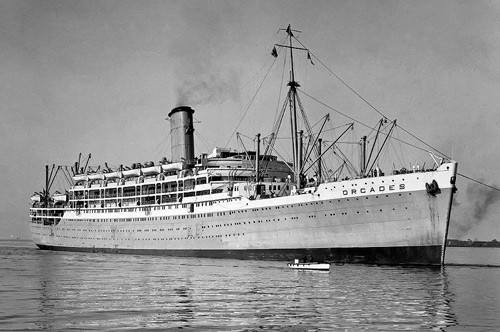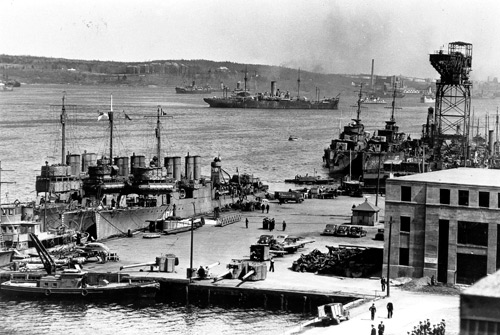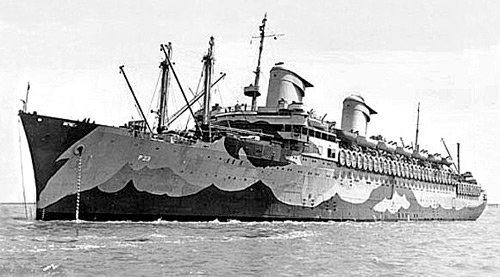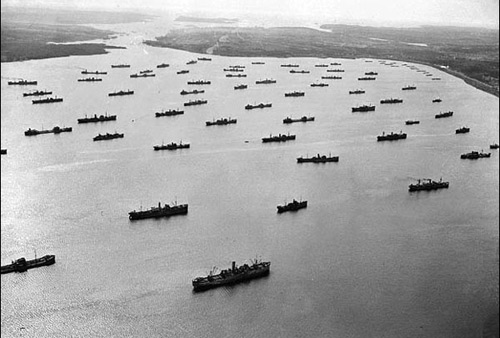

A Long Journey begins
When Roy boarded the SS Orcades on 27th October 1941 he could never have imagined what lay ahead or that he would not return home for over four years.
The Orcades along with the Andes, Warwick Castle and Reno Del Pacifico sailed from Liverpool on 28th October 1941 and on the same day the Oronsay left Avonmouth. The vessels were heading for the Tyne where on the 30th October they would rendezvous with the Sobieski, Durban Castle and Duchess of Atholl to form the the Convoy CT 5, carrying the whole of the 18th Division.
Most of the transports were passenger liners or mail ships, converted as troop carriers:
| Vessel | Flag | Tons | Built | Notes |
| ANDES | Br | 25,689 | 1939 | 3169 TROOPS FOR WS 12X |
| DUCHESS OF ATHOLL | Br | 20,119 | 1928 | 3128 TROOPS FOR WS 12X |
| DURBAN CASTLE | Br | 17,388 | 1938 | 1222 TROOPS (INCL 497 FOR CANADA) |
| ORCADES | Br | 23,456 | 1937 | 3281 TROOPS FOR WS 12X |
| ORONSAY | Br | 20,043 | 1925 | 3124 TROOPS FOR WS 12X |
| REINA DEL PACIFICO | Br | 17,702 | 1931 | 2452 TROOPS FOR WS 12X |
| SOBIESKI | Pol | 11,030 | 1939 | 2108 TROOPS FOR WS 12X |
| WARWICK CASTLE | Br | 20,107 | 1930 | 1475 TROOPS FOR WS 12X |
Their escorts were anti-aircraft cruiser Cairo and destroyers Newark, Charleston, Caldwell, Beverley, Badsworth and Croome.
Many of the troops onboard had presumed their destination to be somewhere in the Middle East and they must have been totally baffled at the fact that the convoy set sail on a westerly heading out across the Atlantic.
At the same time as the convoy CT 5 was departing from the Clyde, a convoy of ex US cargo ships comprising the Empire Pintail, Empire Egret, Empire Fulmar, Empire Widgeon, Empire Peregrine, and Empire Oriole departed from Halifax, Nova Scotia.
This convoy was escorted by US battleship New Mexico, aircraft carrier Yorktown, light cruisers Philadelphia and Savannah, and destroyers Morris, Hughes, Sims, Hammann, Anderson, Mustin and Russell of the 2nd Destroyer Squadron.
In mid Atlantic the escorts traded convoys and the US escort took convoy CT 5 towards Halifax. The British escort took the convoy, designated Tango, and proceeded to the North Channel.
The British convoy arrived at Halifax harbour in Nova Scotia on 8th November after twelve days at sea. After only a short time in her berth, the Orcades and other vessels of the convoy began disembarking.
The planning for this highly secret Anglo-American mission began in early August that year with a meeting between President Franklin D. Roosevelt and Winston Churchill in Placentia Bay, Newfoundland. This meeting between the two nations was known as the Atlantic Charter Conference.
The result of the conference was a joint declaration called the Atlantic Charter, a series of eight principles including defending the rights of freedom and speech and a right of nations to peacefully co-exist. In the months following this declaration all the Allied nations pledged their support for its principles and it finally became known as the United Nations declaration of January 1, 1942.
The two leaders established a good rapport and although Churchill had hoped for the promise of assistance in the war against Nazi Germany no assurances of American help were received at this meeting. Churchill feared that Rommel was moving towards the Suez Canal and this would close off a vital route to reinforce the Middle East.
On 1st September 1941 Churchill sent a message to Roosevelt again asking for help. President Roosevelt was still unable to give a positive response since there was a strong body of resistance in America against joining the war.
However, the events of September 4th 1941 would bring Americas involvement in the European war a step nearer, for it was on that day when the destroyer USS Greer came under attack from a German U-boat. Roosevelt said that Germany had been guilty of an act of piracy and gave authority to the Unites States Navy to implement a shoot on sight order against any axis vessel in the Atlantic.
This incident also gave the President justification in responding positively to Churchill's recent request for assistance and on September 5th he assured the British leader that six troop ships and an American Navy escort would be provided to carry the urgently needed troops to the Middle East and thus Convoy WS 12X was conceived. Furthermore it was agreed to keep Halifax as their port of departure rather than one of the American ports such as New York or Boston.
In Halifax, Roy and his comrades found they had only a short walk before embarking their new transport the USS West Point.
West Point was a new name for the former steamship SS America which had been requisitioned and refitted as a troop carrier. The 35,000 ton SS America had been built in 1940 and was (at that time) the largest, fastest and most luxurious liner ever to be built in the United States.
However, she was now stripped of much of her splendour. Gone were the magnificent dining rooms, cocktail bars, the carpets and deck chairs. A row of life rafts covered her Promenade deck windows, and four tier standee bunks were installed everywhere, giving her an initial capacity of 5,400 men. The Smoking Room and Cocktail Lounge became the officers' ward room and mess, the Library became a latrine, the Lounge was a movie theatre. The Ballroom had bunks for 545 men and the Dining Room was the enlisted men's mess with the adjoining foyer used to wash mess kit.
The open decks were equipped with a powerful anti-aircraft battery. The black hull, the white upper decks and the red, white, and blue stacks were painted with grey camouflage.
Little did any of the troops who boarded her know at that time that this would be their "home" for the next three months.
Boarding the West Point with Roy and his RAOC comrades were men of the 55th Brigade of the 18th Division comprising the 1/5th Battalion the Sherwood Foresters, 1st Battalion the Cambridgeshire Regiment and the 5th Battalion Bedfordshire and Hertfordshire Regiment. Over 100 men of an American Army Field Service company also boarded. Loaded to capacity a total of 5,538 troops embarked the ship.
Troops from the remaining vessels of convoy CT 5 transferred to several other converted American liners. The 53rd Brigade comprising the 5th & 6th Royal Norfolks and the 2nd Cambridgeshire Regiment changed to the USS Mount Vernon, (former the SS Washington).
The 54th Brigade comprising 4th Royal Norfolks and the 4th and 5th Suffolk Regiment and the Royal Army Medical Corps, Royal Artillery, Royal Engineers, Royal Army Service Corps, Royal Army Ordnance Corps and the 18th Divisional Troops (9th Royal Northumberland Fusiliers and Recce Corps (5th Loyals) transferred to the USS Wakefield, (former SS Manhattan).
Troops from the 9th Battalion Royal Northumberland Fusiliers were allocated to the USS Orizaba.
Along with the vessels USS Leonard Wood and USS Joseph T Dickman the ships made final preparations for their long journey.
The convoy was designated WS 12X "William Sail" although it became known more famously for it's nickname "Winston's Special".
Halifax to Trinidad
The convoy sailed from Halifax on the 10th November 1941 carrying around 20,000 British troops and their equipment. Roy recalled:
"We sailed on the American convoy from Halifax Canada on the “Miss America” renamed the West Point, part of a convoy of several ships. We had set sail from England almost two weeks earlier on 28th October 1941, having spent nearly 12 months training for desert warfare.
I was in the RAOC light aid detachment attached to the 55th infantry brigade. All the personnel travelled by troopship whilst transport and equipment was carried in a different part if the convoy."
The convoy's escort from Halifax was entirely U S Navy vessels and consisted of the aircraft carrier Ranger, cruisers Quincy and Vincennes, and destroyers Mayrany, McDougall, Moffatt, Rhind, Rowan, Trippe, Wainright and Winslow. The Convoy Commodore was Captain D.B. Beary.
Travelling at a speed of around 15 knots the convoy headed south along the Eastern Seaboard of the United States. They were headed for their first refuelling stop at Port of Spain, Trinidad where they arrived on the 17th November.
The weather had gradually changed from the time when they had departed Nova Scotia and they were now experiencing tropical heat and humidity of the Caribbean. This made life onboard very uncomfortable. The overcrowded conditions coupled with inadequate ventilation was a serious problem, especially at night when the ships hatches were secured because of the strict 'darken ship' regulations.
Accounts from a number of those on board compared the much better arrangements on the Orcades with the overcrowded conditions, long queues at mealtimes and the food served by the American cooks on the West Point. After about a week at sea and to the delight of many of the troops, American cooks were taken out and the RASC took over the catering arrangements.
The convoy lay off shore for the next two days while refuelling and replenishment of supplies took place. With the exception of a small number of American soldiers, no shore leave was granted.
Two days after arriving in Trinidad the convoy was ready to continue their journey. They had originally intended to continue sailing south to allow another refuelling stop in Brasil (mainly for the destroyers). However, because of the "most secret" nature of the mission, it was decided to attach a refuelling vessel (the Cimarron) to the convoy.
Across the Atlantic
The convoy headed out into the mid Atlantic for the next stage of their journey - the 6,000 mile South Atlantic crossing to Cape Town, South Africa.
It was a frustrating time for the troops, not knowing where they were headed and spending a lot of their time below deck. Many had never been at sea before and few had been on board a ship for so long. Water rations had also been imposed, with fresh water available only during meal times.
Troops were exercised on deck in groups of 300-500, allowing them much needed fresh air and sunshine. Their daily routine was also punctuated with the many lifeboat drills which became less frequent as they became more familiar with the procedure. After the evening meal the troops conducted 'sing-songs' on the weather decks to help ease the boredom.
On board the West Point the regimental bands of the Sherwood Foresters, the Cambridgeshires the Bedfordshires and Hertfordshires played a very good part in providing musical entertainment, which was very well received by the troops.
On Sunday November 23rd there was some light relief for the men as on they proceeded towards Lat 000. Long 4041 and prepared to cross the equator. The “Crossing the line” ceremony (an age old tradition for many navies in the world) where the Pollywogs (the uninitiated i.e. those who have not previously crossed the equator) are subjected to various embarrassing ordeals before eventually being tipped backwards into a pool. Once the ceremony is complete, a Pollywog receives a certificate declaring his new status as a Shellback.
Roy recalled that what started out as light hearted merry-making turned a bit rough and he and many of his comrades were chased about by the crew before getting a ducking.
The convoy's progress across the Atlantic didn't pass without incident. On several occasions the destroyers took evasive action after suspected U-boat contact, deploying depth charges as a precaution. Although no positive sightings were ever logged the crew were always on a constant lookout for any threat to the convoy.
It had never been disclosed to the troops onboard that their mission was to travel to Basra, Iraq in the Middle East but these plans would soon be changed.
On the evening of 7th December 1941, a radio message was received saying that the Japanese had bombed Pearl Harbour. It soon followed that as a result of this shocking news America had declared war on Japan. Later, bad news from the Far East would change the lives of those onboard forever.
Two days later the Cape of Good Hope was sighted. By mid afternoon on the 9th December, almost four weeks and around 10,000 miles after leaving Halifax, the ships had docked in Cape Town, South Africa.




